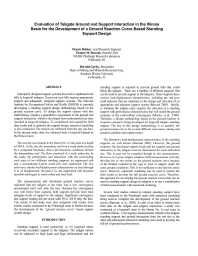Mining Publication: Evaluation of Tailgate Ground and Support Interaction in the Illinois Basin for the Development of a Ground Reaction Curve Based Standing Support Design
Original creation date: July 2009
Improperly designed support systems have led to unplanned roof falls in longwall tailgates. To prevent such falls requires appropriate support and adequately designed support systems. The National Institute for Occupational Safety and Health (NIOSH) is currently developing a standing support design methodology based on the ground reaction curve. To design the support system with this methodology requires a quantitative assessment of the ground and support interaction, which is developed from instrumented test sites installed in longwall tailgates. To compliment and expand the field data results and to optimize the support design, numerical modeling is also conducted. The models are calibrated from the test site data. In the present study, data was obtained from a longwall tailgate in the Illinois basin. The test site was located in the Herrin No. 6 coal seam at a depth of 500 ft. At the site, the immediate roof was a weak shale overlain by a competent limestone. Above the limestone, sandstone formed the intermediate roof. The floor consisted of a weak underclay. In the study, the performance and interaction with the surrounding rock mass of two different standing supports, an engineered crib and a conventional 4-point wood crib were monitored. The two cribs have similar load-displacement characteristics at least through 6 in of displacement. Beyond 6 in, the engineered crib becomes unstable and begins to strain soften and shed load. The measurements and developed ground reaction curves indicated that the tailgate at the mine was a low convergence environment until well inby the face. Because the convergence was well below their capacity, both supports provide more than adequate levels of support to the tailgate. Significant convergence and support loading did not occur until 90 to 100 ft inby the face. The results of this study were also compared with results from similar studies conducted in the Pittsburgh seam to further advance the development of the "ground reaction curve" based support system design.
Authors: DR Dolinar, TM Barczak, H Gurley
Conference Paper - July 2009
NIOSHTIC2 Number: 20035814
Proceedings of the 28th International Conference on Ground Control in Mining, July 28-30, 2009, Morgantown, West Virginia. Peng SS, Barczak T, Mark C, Tadolini S, Finfinger G, Heasley K, Luo Y, eds., Morgantown, WV: West Virginia University, 2009; :30-37
See Also
- Analysis of the Interaction Between Mobile Roof Supports and Mine Strata
- Evaluation of the Impact of Standing Support on Ground Behavior in Longwall Tailgates
- A First Step in Developing Roof Support Design Criteria Based on Ground Reaction Data for Pittsburgh Seam Longwall Tailgate Support
- Longwall Shield and Standing Gateroad Support Designs - Is Bigger Better?
- Optimizing Secondary Roof Support with the NIOSH Support Technology Optimization Program (STOP)
- Overview of Coal Mine Ground Control Issues in the Illinois Basin
- Pillar and Roof Span Design Guidelines for Underground Stone Mines
- Pumpable Roof Supports: Developing Design Criteria by Measurement of the Ground Reaction Curve
- Technology News 482 - Ground Support Safety Training Video
- Updating the NIOSH Support Technology Optimization Program (STOP) With New Support Technologies and Additional Design Features
- Page last reviewed: 4/1/2015
- Page last updated: 4/1/2015
- Content source: National Institute for Occupational Safety and Health, Mining Program


 ShareCompartir
ShareCompartir
